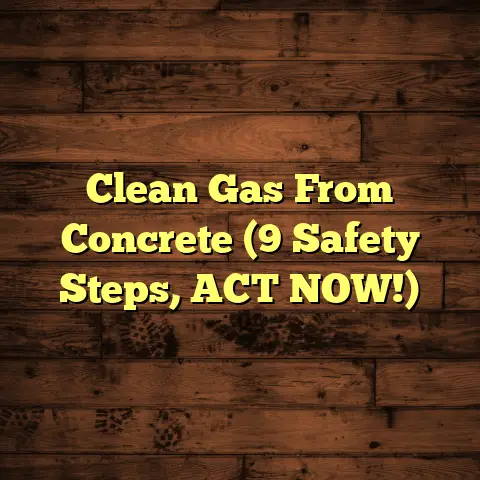Level Concrete With Sand? (3 Tools Needed!)
Ever walked into a room and felt like you were on a subtle tilt?
Maybe it’s the wobbly dining table or the way the rug never quite lays flat.
I’ve seen it countless times in my years as a flooring contractor.
It’s more than just a minor annoyance; uneven concrete floors can actually impact your home’s stability and safety.
Imagine a family gathering, laughter echoing through the house, but punctuated by the frustration of furniture that won’t stay put and a subtle fear of tripping.
I’ve seen the worry etched on homeowners’ faces, the anxiety of trying to create a welcoming space when the very foundation feels off.
But here’s the good news: there’s hope!
Leveling concrete with sand is a practical, achievable solution that can bring peace and comfort back to your home.
And guess what? It’s something you can tackle yourself with the right knowledge and the right tools.
Let’s dive in!
Understanding the Importance of Level Concrete
Why is level concrete so crucial anyway?
Well, think of it as the foundation (literally!) for everything else in your home.
An uneven surface can lead to a whole host of problems, both big and small.
- Water Pooling: Low spots become magnets for water, potentially leading to mold growth and structural damage.
- Structural Instability: Uneven floors can put stress on walls and other structural elements, potentially leading to cracks and other issues down the road.
- Safety Hazards: Tripping hazards are a serious concern, especially for young children and older adults.
- Aesthetics: Let’s be honest, an uneven floor just looks bad. It can throw off the whole look of a room and make it feel less inviting.
I’ve seen firsthand the emotional toll that uneven floors can take.
It’s not just about the inconvenience; it’s about the feeling of unease and instability that it creates in your home.
That feeling of “something’s not quite right” can be surprisingly draining.
On the flip side, a level floor creates a sense of stability, comfort, and peace of mind.
It’s the foundation upon which you can build a beautiful and functional living space.
What Does Leveling Concrete with Sand Entail?
So, what exactly does leveling concrete with sand involve?
In essence, it’s about using sand to fill in those low spots and create a smooth, even surface.
Think of it like spreading frosting on a cake, but instead of frosting, we’re using sand.
The mechanics are pretty straightforward.
You identify the low spots in your concrete floor, then carefully spread sand over those areas, using a leveling rake and trowel to distribute it evenly.
The sand fills in the depressions, creating a level surface that’s ready for flooring or other finishes.
Now, you might be wondering, why sand?
Why not use concrete self-levelers or mud jacking?
Well, sand offers several advantages:
- Cost-Effective: Sand is generally much cheaper than other leveling materials.
- Easy to Work With: It’s relatively easy to spread and manipulate, making it a good option for DIYers.
- Good for Minor Imperfections: Sand is ideal for filling in small cracks and dips, creating a smooth surface without adding excessive weight or thickness.
- Environmentally Friendly: Sand is a natural material, making it a more sustainable choice than some synthetic leveling compounds.
I’ve used all sorts of leveling methods over the years, and I often find that sand is the perfect solution for smaller projects where precision and cost-effectiveness are key.
It’s a simple, yet effective way to achieve a level surface without breaking the bank or overcomplicating the process.
Essential Tools for Leveling Concrete with Sand
Alright, let’s talk tools!
You don’t need a whole arsenal of equipment to level concrete with sand, but there are three essential tools that will make the job much easier and more efficient.
1. Leveling Rake
This is your primary tool for distributing the sand evenly across the concrete surface.
A leveling rake typically has a wide, flat head with teeth or a blade that helps to spread the sand in a consistent layer.
Purpose:
The leveling rake’s main purpose is to distribute the sand evenly across the surface, filling in low spots and creating a consistent base.
It helps you avoid creating mounds or dips in the sand, which would defeat the purpose of leveling.
How it’s Used:
You simply push or pull the rake across the sand, using the teeth or blade to spread it out evenly.
It’s important to maintain a consistent angle and pressure to ensure a uniform layer of sand.
I like to use overlapping strokes to blend the sand seamlessly and avoid creating ridges.
Tips for Selecting the Right Rake:
- Width: Choose a rake with a width that’s appropriate for the size of your project. A wider rake will cover more ground quickly, but it can be more difficult to maneuver in tight spaces.
- Material: Look for a rake made of durable materials like steel or aluminum. These materials will withstand the wear and tear of the job and won’t bend or break easily.
- Handle Length: Make sure the handle is long enough for you to reach all areas of the floor comfortably. A longer handle will also give you more leverage, making it easier to spread the sand.
Techniques for Effectively Distributing Sand:
- Start with a small amount of sand: It’s easier to add more sand than to remove excess.
- Use overlapping strokes: This will help to blend the sand seamlessly and avoid creating ridges.
- Maintain a consistent angle and pressure: This will ensure a uniform layer of sand.
- Work in small sections: Focus on leveling one section of the floor at a time, rather than trying to tackle the whole area at once.
- Check your progress frequently: Use your concrete level to check the flatness of the surface as you work.
2. Trowel
Once you’ve used the leveling rake to distribute the sand, the trowel comes in to play.
This tool is used to smooth out the sand and create a polished, even finish.
Purpose:
The trowel’s main purpose is to smooth out the sand, eliminating any small bumps or imperfections.
It also helps to compact the sand slightly, creating a more stable base for your flooring or other finishes.
How it’s Used:
Hold the trowel at a slight angle and use it to glide over the sand, applying gentle pressure.
Overlap your strokes to blend the sand seamlessly and create a smooth, even surface.
I like to use a circular motion to eliminate any swirl marks and create a truly polished finish.
Different Types of Trowels:
- Margin Trowel: A small, rectangular trowel that’s ideal for working in tight spaces and around edges.
- Finishing Trowel: A larger, rectangular trowel that’s used to smooth out large areas of sand.
- Notched Trowel: A trowel with notches cut into the blade, which is used to apply adhesive for flooring or tiles.
Choosing the Right Trowel:
- Size: Choose a trowel that’s appropriate for the size of your project. A larger trowel will cover more ground quickly, but it can be more difficult to maneuver in tight spaces.
- Material: Look for a trowel made of durable materials like steel or stainless steel. These materials will resist rust and corrosion and will last for years.
- Handle: Make sure the handle is comfortable to grip and hold. A comfortable handle will reduce fatigue and make the job easier.
3. Concrete Level
This is arguably the most important tool of all.
A concrete level is used to ensure that the surface is perfectly flat.
Without it, you’re just guessing!
Purpose:
The concrete level’s main purpose is to verify that the surface is perfectly flat and level.
It’s used to check your progress as you work and to make sure that you’re achieving the desired results.
How it’s Used:
Place the level on the sand surface and check the bubble.
If the bubble is centered between the lines, the surface is level.
If the bubble is off-center, the surface is uneven and needs to be adjusted.
I like to check the level in multiple directions to ensure that the surface is level in all planes.
Key Measurements to Consider:
- Length: Choose a level that’s long enough to span the largest unevenness in your floor. A longer level will give you a more accurate reading.
- Accuracy: Look for a level with a high degree of accuracy. A more accurate level will give you more precise results.
- Durability: Choose a level made of durable materials like aluminum or steel. These materials will withstand the wear and tear of the job and won’t bend or break easily.
With these three tools in hand, you’re well on your way to leveling your concrete floor with sand.
Step-by-Step Guide to Leveling Concrete with Sand
Now that you’ve got your tools, let’s get down to business.
Here’s a comprehensive, step-by-step guide to leveling concrete with sand:
Step 1: Preparation
- Clean the Concrete Surface: Remove any dirt, debris, or loose material from the concrete surface. I usually use a broom or a vacuum cleaner for this step.
- Identify Low Spots: Use a concrete level to identify the low spots in the concrete surface. Mark these areas with a pencil or chalk.
- (Image Description: A person using a level to identify low spots on a concrete floor, marking them with chalk.)
- Protect Surrounding Areas: Cover any surrounding areas that you don’t want to get sand on, such as walls or furniture. I like to use plastic sheeting or drop cloths for this purpose.
- (Image Description: Plastic sheeting protecting walls and furniture around a concrete floor being prepared for leveling.)
Step 2: Applying the Sand
- Pour Sand onto Low Spots: Pour a small amount of sand onto the low spots that you identified earlier. Start with a small amount of sand; you can always add more later.
- (Image Description: Pouring sand onto a low spot on a concrete floor.)
- Distribute the Sand: Use a leveling rake to distribute the sand evenly across the low spots. Use overlapping strokes to blend the sand seamlessly and avoid creating ridges.
- (Image Description: Using a leveling rake to distribute sand evenly across a low spot on a concrete floor.)
Step 3: Smoothing and Leveling
- Smooth the Sand: Use a trowel to smooth out the sand and eliminate any small bumps or imperfections. Hold the trowel at a slight angle and use it to glide over the sand, applying gentle pressure.
- (Image Description: Smoothing sand with a trowel on a concrete floor.)
- Check for Level: Use a concrete level to check the flatness of the surface. Place the level on the sand surface and check the bubble. If the bubble is centered between the lines, the surface is level. If the bubble is off-center, adjust the sand as needed.
- (Image Description: Checking the level of a sand-covered concrete floor with a concrete level.)
- Repeat as Needed: Repeat steps 2 and 3 until the surface is perfectly level. Be patient and take your time; it’s better to get it right the first time than to have to redo it later.
Step 4: Compacting the Sand (Optional)
- Compact the Sand: If desired, you can compact the sand to create a more stable base. I sometimes use a hand tamper or a roller for this purpose.
- (Image Description: Compacting sand on a concrete floor using a hand tamper.)
Step 5: Curing and Finishing
- Cure the Sand: Allow the sand to cure for at least 24 hours before applying any flooring or other finishes. This will allow the sand to settle and compact further.
- Clean Up: Once the sand has cured, clean up any excess sand or debris from the surrounding areas.
- Apply Flooring or Finish: Apply your desired flooring or finish to the leveled concrete surface.
Common Challenges and How to Overcome Them
Even with the best tools and instructions, you might encounter some challenges along the way.
Here are a few common issues and how to overcome them:
- Moisture: If the concrete surface is damp, the sand may not adhere properly. Make sure the surface is completely dry before applying the sand. You can use a dehumidifier or a fan to speed up the drying process.
- Uneven Distribution: It can be tricky to distribute the sand evenly, especially in large areas. Take your time and use overlapping strokes with the leveling rake to ensure a uniform layer of sand.
- Settling: The sand may settle over time, especially if it’s not properly compacted. Consider using a sand with a higher density or compacting the sand with a hand tamper or roller.
- Cracking: If the concrete surface has large cracks, the sand may not be able to fill them effectively. Consider using a concrete patching compound to fill the cracks before applying the sand.
- Dust: Working with sand can be dusty, so it’s important to wear a dust mask and eye protection. You can also dampen the sand slightly to reduce dust.
I’ve seen all sorts of unexpected situations arise on job sites, from surprise rainstorms to hidden cracks in the concrete.
The key is to stay flexible, adapt to the situation, and don’t be afraid to ask for help if you need it.
Final Touches and Maintenance
Once you’ve leveled your concrete floor with sand, there are a few final touches you can add to enhance its appearance and longevity.
- Sealing: Consider sealing the surface with a concrete sealer. This will help to protect the sand from moisture and stains and will make it easier to clean. There are various types of sealers available, so choose one that’s appropriate for your needs and the type of flooring or finish you’ll be applying.
- Regular Inspections: Inspect the surface regularly for any signs of settling, cracking, or damage. Address any issues promptly to prevent them from worsening.
- Cleaning: Clean the surface regularly with a mild detergent and water. Avoid using harsh chemicals or abrasive cleaners, as these can damage the sand or sealer.
Conclusion: Reaffirming the Value of a Level Surface
Leveling concrete with sand might seem like a simple task, but it can have a profound impact on your home and your well-being.
A level surface not only enhances the aesthetics of your space but also creates a sense of stability, comfort, and peace of mind.
It’s the foundation upon which you can build a beautiful and functional living space, a place where you can relax, entertain, and create lasting memories with your loved ones.
I’ve seen firsthand the transformation that leveling concrete with sand can bring to a home.
It’s not just about fixing a physical problem; it’s about creating a more welcoming, comfortable, and enjoyable living environment.
So, if you’re tired of wobbly furniture, tripping hazards, and that nagging feeling that something’s not quite right, I encourage you to take action.
Empower yourself to tackle your concrete leveling project with confidence, knowing that you have the knowledge, the tools, and the support to achieve a level surface that will enhance your home and your life.
Now, I’d love to hear from you.
Have you ever tackled a concrete leveling project?
What challenges did you face, and what tips would you share with others?
Share your experiences or ask questions in the comments section below, and let’s build a community of support and inspiration!





